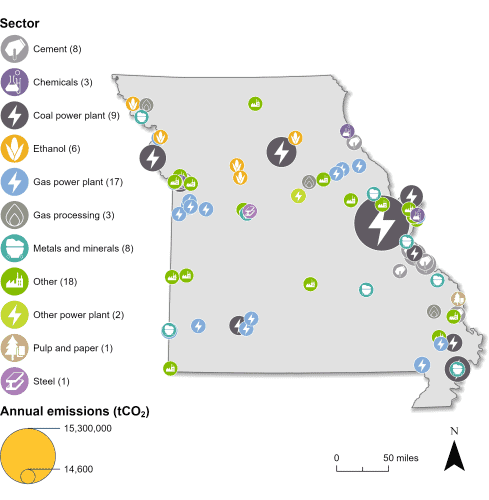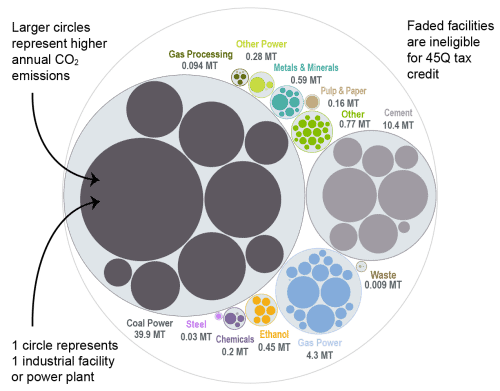Missouri Carbon Capture Opportunities

Carbon management technologies can lower emissions across a variety of sectors in Missouri and bring jobs and private investment to the state. Of the 103 industrial and power facilities in the state, 75 are eligible for the 45Q federal tax credit. The power sector is the state’s highest emitter, and most of Missouri’s gas and coal plants are 45Q-eligible. The cement sector also plays a prominent role in Missouri’s industrial landscape, and all eight cement facilities in the state are eligible. In total, all 75 eligible facilities emit around 56 million metric tons of carbon dioxide (CO2) annually, representing 99 percent of total annual CO2 emissions in Missouri.
Missouri has enacted minimal legislation related to clean energy and carbon management deployment. As such, the state could make significant progress in future legislative sessions to develop a supportive regulatory framework and fully realize the economic and environmental benefits of carbon management.

Industrial and Power Facilities in Missouri
Missouri has 103 industrial and power facilities, 75 of which are eligible for the 45Q tax credit. The state’s power sector is its highest emitter, representing about 78 percent of Missouri’s CO2 emissions annually. As the state’s second-highest emitter, Missouri’s cement industry also presents significant potential for emissions reduction through carbon capture. Missouri hosts eight cement facilities, all of which are 45Q-eligible. The industry has already begun taking advantage of carbon management technologies, as evidenced by a Holcim US partnership with the US Department of Energy to develop carbon capture and storage systems at its cement plant in Ste. Genevieve, Missouri. Missouri also has eight metals and minerals facilities, six ethanol plants, three chemicals facilities, and 28 other 45Q-eligible facilities. In total, all 75 eligible facilities emit around 56 million metric tons of CO2 annually, representing 99 percent of total annual emissions in Missouri.
Beyond capture, Missouri has some potential to safely store CO2 underground in geologic formations and is a member of the Plains CO2 Reduction Partnership, which has explored and identified favorable geologic formations for carbon storage in the state and region. The state also hosts the Missouri Carbon Sequestration Project, a federally supported research project to assess the feasibility of carbon storage at Missouri power plants. Additionally, Missouri is well-positioned as a corridor for transporting CO2 regionally.

Source: EPA GHGRP, 2024.
Legislative Context for Carbon Management
As of May 2025, Missouri has not enacted any legislation specifically addressing carbon management technologies or deployment. The state has shown some interest in building out clean energy infrastructure and reducing emissions, with a Clean Energy and Renewable Portfolio Standard enacted in 2007 that required 15 percent renewable energy by 2021.
Given the minimal amount of existing policy in Missouri related to carbon management, the state has an opportunity to make significant progress on this front in future legislative sessions.
This bubble diagram shows the number of facilities and corresponding annual CO2 emissions for each industry in Missouri. The darker large bubbles are eligible for the 45Q carbon capture tax credit, while the faded bubbles are too small to be eligible. The total amount of CO2 emissions in Missouri is listed for each industry in million metric tons.

Source: EPA GHGRP, 2024.
Last updated: June 2025

